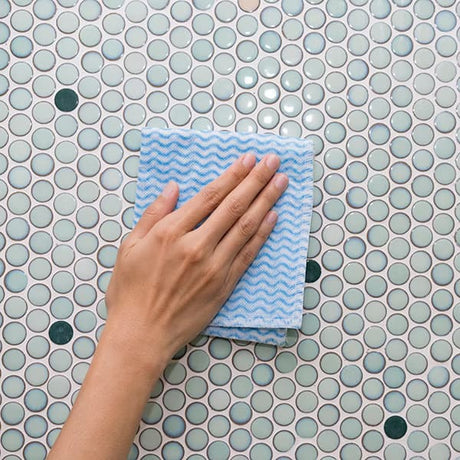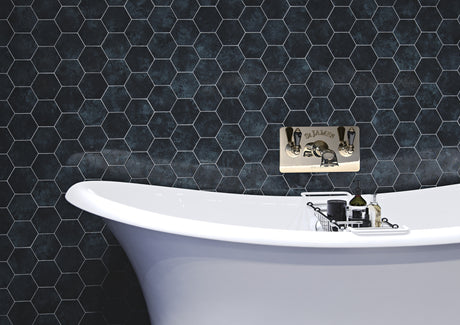How to Remove Mould from the Bathroom
Mould is one of the most common yet unsightly issues in bathrooms. Left unaddressed, it doesn't just ruin the aesthetic of your bathroom; it also poses significant health risks, such as allergies and respiratory problems. Mould thrives in damp, warm environments, making the bathroom its perfect breeding ground. Thankfully, with the right techniques and tools, it's possible to remove mould effectively and protect your space from its return.
This guide from Asturias Bathrooms will provide you with an in-depth understanding of black mould, how to remove it, and what you can do to prevent it from creeping back. Whether you're dealing with mould on tiles, grout, or silicone sealant, we've got you covered.
Understanding Black Mould
What Causes Black Mould?
Black mould forms in areas that are constantly exposed to moisture and humidity. Bathrooms, with their combination of warm temperatures, steam, and water splashes, provide an ideal setting. Mould feeds on organic material, like skin cells and soap scum, making bathroom surfaces especially vulnerable.
Where Does Black Mould Thrive?
You're most likely to find black mould:
- On Silicone Sealant around bathtubs, sinks, and showers.
- Between Tiles on walls and floors, particularly in grout lines.
- On the Ceiling or Walls near ventilation fans or windows where moisture collects.
-
Behind Fixtures such as mirrors or cabinets if water seeps in unnoticed.

Essential Tools and Materials
Before tackling black mould, it's crucial to gather all the tools and cleaning agents you'll need:
- Protective gloves and safety goggles (to protect your skin and eyes)
- Microfibre cloths and old rags
- An old toothbrush or scrubbing brush
- White vinegar (5% acidity)
- Baking soda
- Bleach or a commercial mould remover
- Spray bottle
- Cling film (optional)
- Toilet roll or cotton swabs for precision cleaning
Pro Tip: Always ventilate your bathroom when working with cleaning chemicals or during mould removal, as spores can spread during the process.
Natural Cleaning Method
If you're tackling a minor mould issue, this natural cleaning method using vinegar and baking soda is highly effective.
Step 1. Mix the Solution
Create a thick paste by combining one cup of white vinegar with two to three teaspoons of baking soda. Vinegar serves as a natural mould killer, while baking soda provides gentle abrasiveness.
Step 2. Apply the Mixture
Using a damp sponge or cloth, apply the mixture generously to the affected areas, focusing on mouldy grout lines and silicone edges.
Step 3. Leave It to Sit
Allow the paste to sit for at least 10 minutes. This gives it time to penetrate the mould and break it down.
Step 4. Scrub Thoroughly
Break out your toothbrush or scrubbing brush and clean in circular motions. Pay extra attention to areas that are harder to reach, as these often harbour the most mould.
Step 5. Rinse and Dry
Once scrubbed, rinse the area with a cloth dipped in clean water, and then dry thoroughly. Remember, mould thrives in moisture, so aim to leave surfaces bone dry.
Using Bleach for Stubborn Mould
If natural methods aren't effective, bleach comes in as a stronger solution.
Step 1. Create a Bleach Solution
Mix one part bleach with four parts water in a spray bottle. Shake well to combine.
Step 2. Spray the Mould
Apply the bleach solution liberally to the mould-affected areas. Allow it to sit for 15–30 minutes to kill spores and loosen stains.
Step 3. Scrub and Rinse
Scrub the area with a brush, rinse thoroughly, and dry completely. For stubborn mould, consider covering the sprayed area with cling film and leaving it overnight to increase its effectiveness.
Caution: Always ensure the bathroom is ventilated when using bleach to avoid inhaling fumes.
Preventing Black Mould
Prevention is key to keeping your bathroom looking fresh and clean. Here's how to mould-proof your space:
Ensure Proper Ventilation
- Extractor Fan: Install or switch on an extractor fan during and after showers.
- Open Windows: Keep windows slightly open to allow steam to escape.
- Dehumidifiers: Use a dehumidifier to regulate moisture levels in the bathroom.
Keep Surfaces Dry
- Wipe down tiles, sinks, and bath screens after each use.
- Shake out bath mats and shower curtains to prevent moisture build-up.
Regular Cleaning
A consistent cleaning routine can stop mould before it starts. Use a mould-resistant spray on surfaces weekly, and clean grout and sealant often to prevent the build-up of organic matter.
Use Mould-Resistant Products
Replace old sealant with mould-resistant silicone products. These specialised sealants contain additives that inhibit mould growth.
Address Water Leaks Immediately
Leaky taps or hidden plumbing issues create damp environments that are ideal for mould. Repair leaks promptly and check for signs of water damage behind fixtures.
Replacing Silicone Sealant
When mould has deeply penetrated the silicone sealant, no amount of cleaning will remove it. Replacing the sealant is the most effective solution.
Step 1. Remove Old Sealant
Use a utility knife or silicone remover to scrape away the old sealant. Be thorough.
Step 2. Clean and Dry
Clean the area with a mould remover and ensure it is completely dry before proceeding.
Step 3. Apply New Sealant
Using a caulking gun, apply a fresh bead of silicone sealant. Smooth it with a silicone tool or damp finger for a clean finish.
Step 4. Allow to Cure
Follow the sealant manufacturer's instructions for curing times. Avoid using the area during this period.
FAQ About Mould Removal
How do I get rid of black mould in my bathroom?
Black mould can be removed using a natural vinegar and baking soda solution or a diluted bleach spray. Scrub the affected areas, rinse thoroughly, and dry completely to prevent regrowth.
How do you remove black mould from shower silicone?
Apply a cleaning solution (vinegar or bleach) to the silicone, scrub, and cover with cling film overnight for stubborn sections. If the mould persists, replace the silicone sealant.
How do you prevent the return of black mould?
Improve ventilation, clean regularly, wipe surfaces dry, and use a mould-resistant sealant when applicable.
Restore Your Bathroom to Its Best
A mould-free bathroom isn't just about aesthetics; it's essential for a healthier home. Whether you're scrubbing stubborn silicone or replacing trim that's seen better days, maintaining a consistent cleaning routine and addressing issues promptly will keep mould at bay. Start with these tips today and enjoy a fresher, healthier bathroom for years to come.














